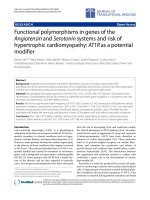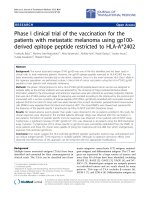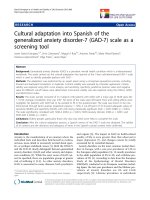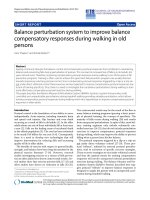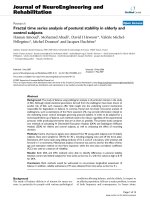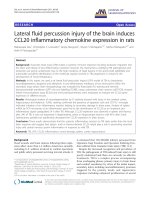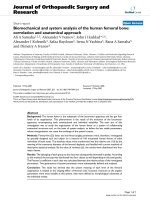báo cáo hóa học:" Biomechanical and system analysis of the human femoral bone: correlation and anatomical approach" docx
Bạn đang xem bản rút gọn của tài liệu. Xem và tải ngay bản đầy đủ của tài liệu tại đây (442.06 KB, 7 trang )
BioMed Central
Page 1 of 7
(page number not for citation purposes)
Journal of Orthopaedic Surgery and
Research
Open Access
Short report
Biomechanical and system analysis of the human femoral bone:
correlation and anatomical approach
Ali A Samaha
1,2,3
, Alexander V Ivanov
3
, John J Haddad*
2,6
,
Alexander I Kolesnik
3
, Safaa Baydoun
4
, Irena N Yashina
3
, Rana A Samaha
5
and Dimetry A Ivanov
3
Address:
1
Department of Anatomy, Faculty of Public Health, Lebanese University, Zahle, Lebanon,
2
Cellular and Molecular Signaling Research
Group, Departments of Biology and Biomedical Sciences, Faculty of Arts and Sciences, Lebanese International University, Beirut, Lebanon,
3
Department of Anatomy, Kursk State Medical University, Russia,
4
Faculty of Arts and Sciences, Lebanese International University, Bekaa, Lebanon,
5
Clinical Laboratory, Faculty of Public Health, Lebanese University, Zahle, Lebanon and
6
Retrospect address: Severinghaus-Radiometer Research
Laboratories, Department of Anesthesia & Perioperative Care, Faculty of Medicine, University of California, San Francisco, CA, USA
Email: Ali A Samaha - ; Alexander V Ivanov - ; John J Haddad* - ;
Alexander I Kolesnik - ; Safaa Baydoun - ; Irena N Yashina - ;
Rana A Samaha - ; Dimetry A Ivanov -
* Corresponding author
Abstract
Background: The human femur is the subsystem of the locomotor apparatus and has got four
levels of its organization. This phenomenon is the result of the evolution of the locomotor
apparatus, encompassing both constitutional and individual variability. The main aim of this
investigation was to study the organization of the human femur as a system of collaborating
anatomical structures and, on the basis of system analysis, to define the less stable parameters,
whose reorganization can cause the exchange of the system's status.
Methods: Twenty-five (25) linear and non-linear (angle) parameters were, therefore, investigated
by specially designed tool and caliper on a material of 166 macerated human femurs of adult
individuals of both sexes. The absolute values were transformed into the relative one (1.0) by the
meaning of the transverse diameter of the femoral diaphysis, and handled with current methods of
descriptive statistical analysis. By the value of variance (q
2
), the results were distributed into four
major classes.
Results: The belonging of each group to the class was subsequently estimated in grades. According
to this method, the excerpt was distributed into four classes as well depending on the total grades.
The Pearson's coefficient in each class was calculated between the relative values of the investigated
parameters. Two generations of system parameters were subsequently defined and analyzed.
Conclusion: This study has derived that the system meaning of each level of the femoral
organization is related to the 'shaping effect' of femoral units' functions. Inasmuch as the angular
parameters were most instable at this system, they were defined as morphological substrates of
the individual variety.
Published: 17 May 2007
Journal of Orthopaedic Surgery and Research 2007, 2:8 doi:10.1186/1749-799X-2-8
Received: 9 October 2006
Accepted: 17 May 2007
This article is available from: />© 2007 Samaha et al; licensee BioMed Central Ltd.
This is an Open Access article distributed under the terms of the Creative Commons Attribution License ( />),
which permits unrestricted use, distribution, and reproduction in any medium, provided the original work is properly cited.
Journal of Orthopaedic Surgery and Research 2007, 2:8 />Page 2 of 7
(page number not for citation purposes)
Background
The kinematical chain of the low extremity can be desig-
nated as a crank mechanism, thus reciprocating the foot
motion into rotary motion through the hip that in turn is
being transformed into the ascending variable directive
torsion movements of the flexed sloping spiral of the
spine [1,2].
While the human femur is an element of the non-linear
system of the locomotor's apparatus (as the super system
for the femur), functionally dependent upon the other
elements of the super system, being some time a subsys-
tem, the elements of which are epiphysis and diaphysis,
the investigation of its system and anatomical organiza-
tion has not only theoretical, but also, perhaps, direct
practical and clinical significance [1-5].
Nowadays, not a single endoprothesis used for the
replacement of the hip joint considers the constitutional,
individual and other anatomical features of the patient's
hip joint. This is why among other reasons there develop
complications at various postoperative stages, which may
affect the femoral component of the implant [1,3,4,6-10].
The more rare complication after the total replacement of
the hip joint is the dislocation of the implant's head [1-5].
Considering the fact that the greater part of models has
the fixed moment of the shaft-neck angle (SNA) and the
implant head's diameter is essentially less than that of the
femur, the main prophylactic means is not only the crea-
tion of new implant models, but the creation of new
methods of replacement, dependent on the individual
anatomic peculiarities as well [5-10].
The femur is one of most investigated bones of the human
skeleton. A myriad number of reference literature is
devoted to its anatomy, sexual polymorphism, race and
age transformations [2,4,7,9,11-17]. However, there is
discrepancy as regards the angle meanings of the parame-
ters and angle correlation to the linear characteristics of
the femur. Thus, the size of the SNA according to Wagner
and colleagues [16] varies from approximately 125° up to
132°. Furthermore, according to Nikitiuk and Ovsiankin
[17], its size varies from 109° up to 153° and there is no
angle meaning depending on sex or gender. The scope of
the angle meaning of the anteversion, according to
numerous investigations [10-18], is roughly 74°. Also the
literature data of the absolute meaning of the femur's
head, other linear parameters, and transformation age are
unequal [8,9,11,12].
Moreover, there is consensus amongst researchers who
consider that there is a group of factors (at the macro- and
microscopic levels of the femur as a system) that influence
the solidity of the proximal epiphysis and its stability
towards the load and damage. The mechanism of this cor-
relation has not been studied yet [5,7,13-16].
The minimal availability or lack of information about the
correlation of the linear and angle parameters of the
femur does not allow the determination of the anatomic
structure of the femur as a unit of the non-linear system,
thus functioning on the basis of the heuristic self-organi-
zation [16-18]. Therefore, there is no possibility to
describe the human femur as a subsystem of the locomo-
tor's apparatus and, subsequently, the opportunity to cre-
ate an adequate mathematical model of the whole
skeleton is rather diminishing.
The aim of this investigation, necessarily, is to specifically
determine the group and level of the geometric system
base parameters, thus analyzing the femur structure on
the basis of a complex and thorough investigation.
Methods
Anatomical samples and analysis
The bones from the anatomical museums of several Rus-
sian universities were used. The age of each case was esti-
mated using anatomical evidences, such as complete
ossification of the epiphyseal lines and apophyses. Fur-
ther, the age of every case was ≥ 25 years. However, gen-
ders were not established as they were not considered
falling within the scope of this study.
Approximately, 166 macerated human femurs of adult
individuals of both sexes without visible symptoms of
bone pathology taken from the anatomical museums of at
least three Russian medical universities were investigated.
Twenty-five (25) linear and angle parameters were studied
using a specially designed tool and caliper (Figures 1A and
1B). The analysis package of the Excel XP program was
also used. All the investigating parameters of the femur
were divided into groups (Table 1), thereby executing the
motions of the hip joint, knee joint and the support func-
tion of the thigh.
Statistical analysis and correlation
The absolute values were transformed into relative values
(the transverse diameter of the femoral diaphysis was cho-
sen as the unit of measurement for every bone) and han-
dled with descriptive statistics. By the value of variance
(q
2
), the results were distributed into four classes. The
belonging of each group to the class was estimated in
grades. According to this method, depending on the total
grades, the excerpt was distributed into four classes recur-
rently. The bones, having the total sum of grades less than
M - 2q
2
(M – expected value) were considered the 1
st
class,
M - q
2
the 2
nd
class, M + q
2
the 3
rd
class and M + 2q
2
the 4
th
class.
Journal of Orthopaedic Surgery and Research 2007, 2:8 />Page 3 of 7
(page number not for citation purposes)
All the values were normalized (the procedure of division
of the meaning of each linear parameter on the meaning
of the transverse diameter of the femoral diaphysis). In
this case, the deviation of the measurement becomes
unimportant. Furthermore, the absolute values were nor-
malized by the meaning of the transverse size of the fem-
oral shaft at each case. The Pearson's coefficient in each
class was subsequently calculated among the relative val-
ues of the investigated parameters (Sigmoid deviation).
Each measurement (using our device and caliper, see
below) was produced four (4) times by one researcher and
then average values on each investigated linear or angular
parameter were used for the following analysis. As it is
well known, the repeatability of the measurement can be
described (characterized) directly or indirectly by several
parameters, such as standard deviation (S.D.), dispersion,
standard error of the mean (S.E.M.), etc. In this case, the
repeatability of the measurement is depending on two (2)
parameters: accuracy of involved researcher and "device
mistake." One researcher and one device + following nor-
malization using the value of the transverse size of the
femoral shaft (measured by the one researcher and one
caliper with the same accuracy and "device mistake"),
then drop down comments, concerning repeatability of
the measurement. For example: X (true value of any linear
parameter) + x (current mistake of measurement)/D (true
value of the transverse size of the femoral shaft) + d (cur-
rent mistake of measurement) = A (normalized value of
measured linear parameter).
The standard deviation ("n-1" method) was used for cate-
gorization of the data (linear and angular parameters) in
four (4) quarters (groups) by each investigated parameter
– upper category (group, class, type) of the data, etc. There
were four (4) groups (quarters, types, classes of bones)
with different presenceof the values at each one. However,
representatives at each group have found some 'outstand-
ing" bones whose parameters were categorized to another
quarter. The question is: what is the reason of that devia-
tion from the main stream? We would propose that, if we
were going to analyze correlations in between average val-
ues of numerous linear and angular parameters (previ-
ously normalized) measured up on different and too
variable objects (bones), then the reason of variability is
unknown but the dispersion of the data mostly is normal.
We should, therefore, use the standardcut-off point for
categorization of the data: X x. Thus, the four (4) groups
should include the following: first (the meaning of the
value more than X+x); second (the meaning of the value
is at the interval X + X+x); third (the meaning of the value
is at the interval X-x+X); and forth (the meaning of the
Table 1: The presence of investigated parameters in the functional groups.
Groups Types Parameters
Executing the motions of the hip joint Linear Head of the femur:
- Horizontal diameter 1E
- Vertical diameter 2F
Neck of the femur:
- Horizontal diameter 3G
- Vertical diameter 4H
- Anterior length 5I
- Posterior length 6J
- Superior length 7L
- Inferior length 8K
- Transverse size of the proximal epiphysis 9M
- intertrochanteric distance 10 N
Angular - Diaphysis-neck angle 11 A
- Anteversio of the neck 12 B
- Rotation of the head 13 C
Executing the motions of the knee joint Linear - The length of the lateral condyle 14 R
- The length of the medial condyle 15 S
- The transverse size of the patellar surface 16 T
- Internal intercondylar distance 17 U
- External intercondylar distance 18 V
Executing the support function Linear - Femoral obliquity 19 O
- The anterior diameter of the diaphysis 20 P
- The length of the femur 21 Q
Angular - Femoral declination 22 D
Base group Linear - The anatomical length of the femur 23
- The functional length of the femur 24
- The transverse diameter of the diaphysis 25
Journal of Orthopaedic Surgery and Research 2007, 2:8 />Page 4 of 7
(page number not for citation purposes)
value less thanX-x). The 25
th
percentile, interquartile
range and 75
th
percentile as the cut-off points for categori-
zation of the data were not used because the kurtosis and
theskewness were not equal at different classes of bones
and parameters. This feature makes the ordinary descrip-
tive statistics incompletely suitable in the present case.
Results and discussion
For further analysis, the correlation ties with the Pearson's
coefficient exceeding the 0.6 value were also taken (Table
2), as indicated below.
The first group (parameters marked as A – D) consists of
angle parameters exclusively. It should be stated, moreo-
ver, that there are no strong correlations between the
angle and linear parameters in all of the aforementioned
classes. To our best knowledge, this indicates that the
above-stated angle parameters are the system creating fea-
tures of the third range, their influence on the morpho-
functional characteristics of the femur as a total is mini-
mal, and that their absolute meaning characterizes the
individual variability in the limit specified by the super-
system [16].
The second group (parameters marked as E – N) deter-
mines the geometry of the proximal epiphysis of the
femur. More importantly, is that the horizontal and verti-
cal diameters of the femoral head are not only closely
related parameters, but also are strongly related to the
length of the medial condyle because the above-stated
parameters execute the locomotor and thus support the
various functions of the femur, simultaneously. Therefore,
any derivative coefficient which is based on these param-
eters will characterize the quantity and quality of the fem-
oral "functional proportion" and can also be used for the
following classification of femoral bones.
The third group (parameters marked as O – Q) determines
the geometry of the femoral shaft. Amongst them the
length of the femur closely related to the length of the
The special tool (A) for the one-moment measurement of the linear and angular parameters and their applications (B)Figure 1
The special tool (A) for the one-moment measurement of the linear and angular parameters and their applications (B).
A
EF G H
I, L, K J N
M
BC
A
D
B
Journal of Orthopaedic Surgery and Research 2007, 2:8 />Page 5 of 7
(page number not for citation purposes)
medial condyle in the 1
st
and 3
rd
classes; in the 4
th
class,
the parameter is related to the vertical diameter of the
head and the transverse size of the proximal epiphysis.
The fourth group characterizes the 3D cross relations of
anatomical structures of the distal epiphysis (Table 1).
As shown in Figure 2, the strong correlations are stated
between parameters of the forth group in all of the inves-
tigated classes of the femoral bones. This is an illustration
of the functional proportion of the distal epiphysis. Simi-
larly, the length of the lateral condyle correlates with the
parameters T, U and V. This phenomenon confirms the
hypothesis that the medial condyle executes the support-
ing function mainly [1-5].
Analysis of the correlations in the first class confirms the
assumption that the proximal epiphysis is the lever system
acting according to the weight vector, which is generated
at the intertrochanteric area [16,17].
Furthermore, investigating the biomechanics of the hip
joint, Efimov et al. [18] have inferred that the femur can
rotate at the knee joint independently of other segments
of the lower extremity. This is confirmed by 3D relation-
ships between condyles and provided by SNA and the
geometry of the femoral neck.
Despite the anatomical correlations therein derived, how-
ever, we were unable to find a strong relationship between
SNA and linear parameters of both epiphyses in the first,
third and fourth classes. Therefore, the correlation
between the length of the medial condyle and the hori-
zontal diameter of the femoral neck confirms the capabil-
ity of the isolated femoral supination [16-18] (Figure 2).
In summary, the human femur is considered as the sub-
system of the locomotor apparatus with four levels of its
organization. This phenomenon is the result of the evolu-
tion of the locomotor apparatus, encompassing constitu-
tional and individual variability. This investigation
studied the organization of the human femur as a system
of collaborating anatomical structures and, on the basis of
system analysis, identified the less stable parameters,
whose reorganization can cause the exchange of the sys-
tem's status. Since the angular parameters are most insta-
Table 2: Correlation between measured parameters of the femoral bone.
First Class Second Class Third Class Fourth Class
Parameters r
p
Parameters r
p
Parameters r
p
Parameters r
p
FG0.78FG0.80FE0.78FE0.92
E S 0.62 J L 0.61 L J 0.72 G F 0.64
E 0.64
T U 0.89 C B 0.65 S F 0.61 H E 0.71
V 0.92 E 0.62 F 0.71
U V -0.83 S G 0.72 V R -0.74 N K 0.62
R 0.95 F 0.72 N 0.65
V R -0.81 V N 0.70 U R 0.96 J L 0.63
N 0.70 R 0.72 V -0.80
S F 0.66 U R 0.95 T R -0.90 S E 0.60
V -0.74 V 0.84 F 0.63
N -0.61 U -0.93
T V 0.92 T N 0.63 Q S 0.64 V N 0.66
U -0.89 R -0.89 S -0.59
R-0.84 V0.80
N 0.60 U -0.95
QS 0.60 U R 0.90
V -0.76
T R -0.85
V 0.84
U -0.92
M F 0.73
E 0.65
N 0.65
S 0.62
P U 0.61
Q M 0.75
F 0.59
Journal of Orthopaedic Surgery and Research 2007, 2:8 />Page 6 of 7
(page number not for citation purposes)
ble at this system, they are defined as morphological
substrates of the individual variety. This work indicated
that the system meaning of each level of the femoral
organization is related to the 'shaping effect' of femoral
units' functions.
Competing interests
The author(s) declare that they have no competing inter-
ests.
Correlations between investigated parameters in four distributed classes of femoral bonesFigure 2
Correlations between investigated parameters in four distributed classes of femoral bones. Pearson's coefficient 0.6–0.69 (dot-
ted line), 0.7 and above (straight line – positive correlation; broken line – negative correlation).
First class Second class
Third class Forth class
Publish with BioMed Central and every
scientist can read your work free of charge
"BioMed Central will be the most significant development for
disseminating the results of biomedical research in our lifetime."
Sir Paul Nurse, Cancer Research UK
Your research papers will be:
available free of charge to the entire biomedical community
peer reviewed and published immediately upon acceptance
cited in PubMed and archived on PubMed Central
yours — you keep the copyright
Submit your manuscript here:
/>BioMedcentral
Journal of Orthopaedic Surgery and Research 2007, 2:8 />Page 7 of 7
(page number not for citation purposes)
Authors' contributions
All authors have squarely and equally contributed to
developing the experimental, theoretical and statistical
aspects of this article.
Acknowledgements
The authors would like to thank their colleagues at Kursk State Medical
University (KSMU), department of Anatomy, for financial support and crit-
ical assessment of the manuscript.
References
1. Gonzalez MH, Barmada R, Fabiano D, Meltzer W: Femoral shaft
fracture after hip arthroplasty: A system for classification
and treatment. J South Orthop Assoc 1999, 8:240-248.
2. Cummings RG, Cauley JA, Palermo L, Ross PD, Wasnich RD, Black D,
Faulkner KG: Racial differences in hip axis length might
explain racial differences in rates of hip fracture. Study of
Osteoporotic Fractures Research Group. Osteoporosis Int 1994,
4:226-229.
3. Lewinnek GE, Lewis JL, Tarr R, Compere CL, Zimmerman JR: Dislo-
cation after total hip replacement arthroplasty. J Bone Joint
Surg 1978, 60:217-220.
4. Estok DM, Harris WH: Long-term results of cemented femoral
revision surgery using second-generation technique. An
average 11,7-year follow-up evaluation. Clin Orthop 1994,
299:190-202.
5. Farmer ME, White LR, Brody JA, Bailey KR: Race and differences
in hip fracture incidences. Am J Public Health 1984, 74:1374-1380.
6. McCollum DE, Gray WJ: Dislocation after total hip arthro-
plasty. Clin Orthop 1990, 261:159-170.
7. Morrey BF: Instability after total hip arthroplasty. Orthop Clin
North Am 1992, 23(2):237-248.
8. Noble PC: Proximal femoral geometry and the design of
cementless hip replacements. Orthop Rel Sci 1990, 1:86-92
[ />].
9. Noble PC, Alexander JW, Lindahl LJ, Yew DT, Granberry WM, Tullos
HS: The anatomic basis of femoral component design. Clin
Orthop Relat Res 1988, 235:148-165.
10. Turner RS: Postoperative total hip prosthetic femoral head
dislocations. Incidence, etiologic, factors and management.
Clin Orthop 1994, 301:196-204.
11. Chiu FY: The native femoral sulcus as the guide for the
medial/lateral position of the femoral component in knee
arthroplasty: Normal patellar tracking in 690/700 knees – a
prospective evaluation. Acta Orthop 2006, 77:501-504.
12. Spruijt S, van der Linden JC, Dijkstra PD, Wiggers T, Oudkerk M,
Snijders CJ, van Keulen F, Verhaar JA, Weinans H, Swierstra BA: Pre-
diction of torsional failure in 22 cadaver femora with and
without simulated subtrochanteric metastatic defects: a CT
scan-based finite element analysis. Acta Orthop 2006,
77:474-481.
13. L'ubusky M, Mickova I, Prochazka M, Dzvincuk P, Mala K, Cizek L,
Janout V: Discrepancy of ultrasound biometric parameters of
the head (HC – head circumference, BPD – biparietal diam-
eter) and femur length in relation to sex of the fetus and
duration of pregnancy. Ceska Gynekol 2006, 71:169-172.
14. Theodorou SJ, Theodorou DJ, Resnick D: Imaging findings in
symptomatic patients with femoral diaphyseal stress inju-
ries. Acta Radiol 2006, 47:377-384.
15. Wisniewski SJ, Grogg B: Femoroacetabular impingement: an
overlooked cause of hip pain. Am J Phys Med Rehabil 2006,
85:546-549.
16. Wagner A, Sachse A, Keller M, Aurich M, Wetzel WD, Hortschansky
P, Schmuck K, Lohmann M, Reime B, Metge J, Arfelli F, Menk R, Rigon
L, Muehleman C, Bravin A, Coan P, Mollenhauer J: Qualitative eval-
uation of titanium implant integration into bone by diffrac-
tion enhanced imaging. Phys Med Biol 2006, 51:1313-1324.
17. Nikitiuk IE, Ovsiankin NA: The differential diagnosis of post-
traumatic ossifications in the area of the elbow joint in chil-
dren. Vestn Khir Im I I Grek 1997, 156:28-31.
18. Efimov VA, Gorlin IK, Nechaev BN, Trgubov GP, Belavich NF: The
use of new materials and structural-technological equip-
ment in foreign medical technology. Med Tekh 1981, 3:38-43.

